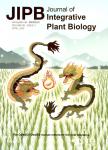Variation in Heat-shock Proteins and Photosynthetic Thermotolerance among Natural Populations of Chenopodium album *** Contrasting Thermal Environments:Implications for Plant Responses to Global Warming
Variation in Heat-shock Proteins and Photosynthetic Thermotolerance among Natural Populations of Chenopodium album *** Contrasting Thermal Environments:Implications for Plant Responses to Global Warming作者机构:Department of BiologySyracuse University Department of Organismic and Evolutionary BiologyHarvard University Department of Environmental SciencesUniversity of Toledo
出 版 物:《Journal of Integrative Plant Biology》 (植物学报(英文版))
年 卷 期:2008年第50卷第11期
页 面:1440-1451页
核心收录:
学科分类:07[理学] 070602[理学-大气物理学与大气环境] 09[农学] 0903[农学-农业资源与环境] 0706[理学-大气科学]
基 金:Supported by grants from the US National Science Foundation to SAH a Consortium for Plant Biotechnology Research Fellowship to DB
主 题:acclimation photosynthesis stress proteins temperature.
摘 要:Production of heat-shock proteins (Hsps) is a key adaptation to acute heat stress and will be important in determining plant responses to climate change. Further, intraspecifc variation in Hsps, which will influence species-level response to global warming, has rarely been examined in naturally occurring plants. To understand intraspecific variation in plant Hsps and its relevance to global warming, we examined Hsp content and thermotolerance in five naturally occurring populations of Chenopodium album L. from contrasting thermal environments grown at low and high temperatures. As expected, Hsp accumulation varied between populations, but this was related more to habitat variability than to mean temperature. Unexpectedly, Hsp accumulation decreased with increasing variability of habitat temperatures. Hsp accumulation also decreased with increased experimental growth temperatures. Physiological thermotolerance was partitioned into basal and induced components. As with Hsps, induced thermotolerance decreased with increasing temperature variability. Thus, populations native to the more stressful habitats, or grown at higher temperatures, had lower Hsp levels and induced thermotolerance, suggesting a greater reliance on basal mechanisms for thermotolerance. These results suggest that future global climate change will differentially impact ecotypes within species, possibly by selecting for increased basal versus inducible thermotolerance.



